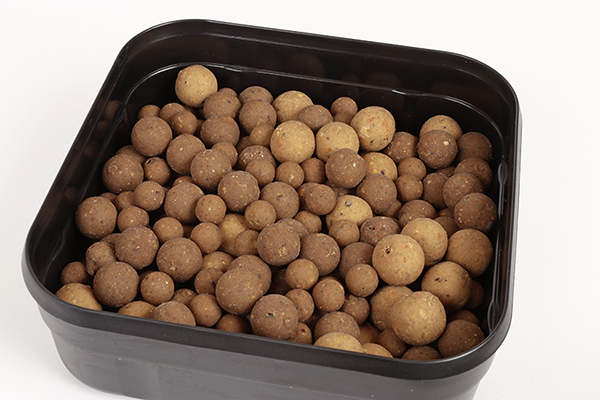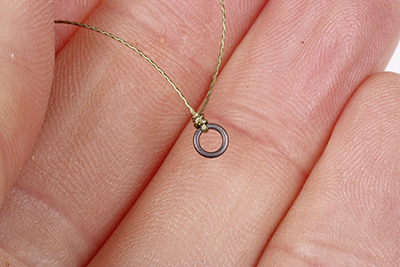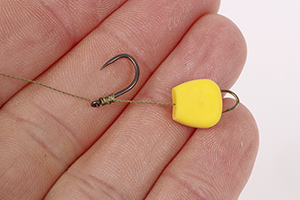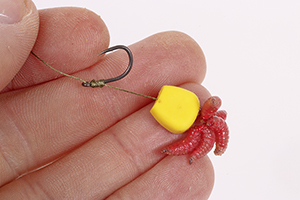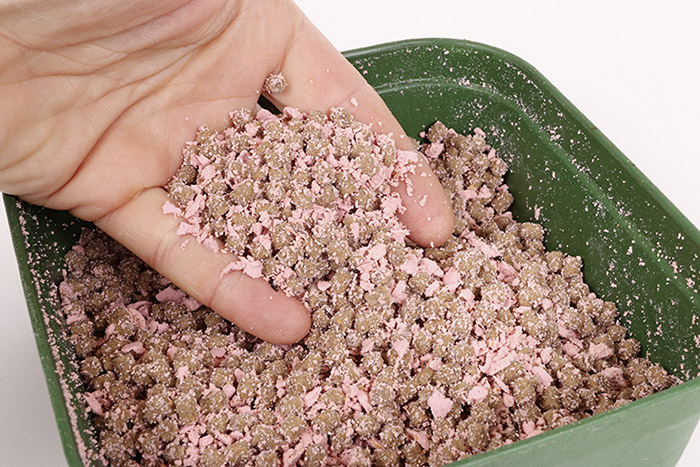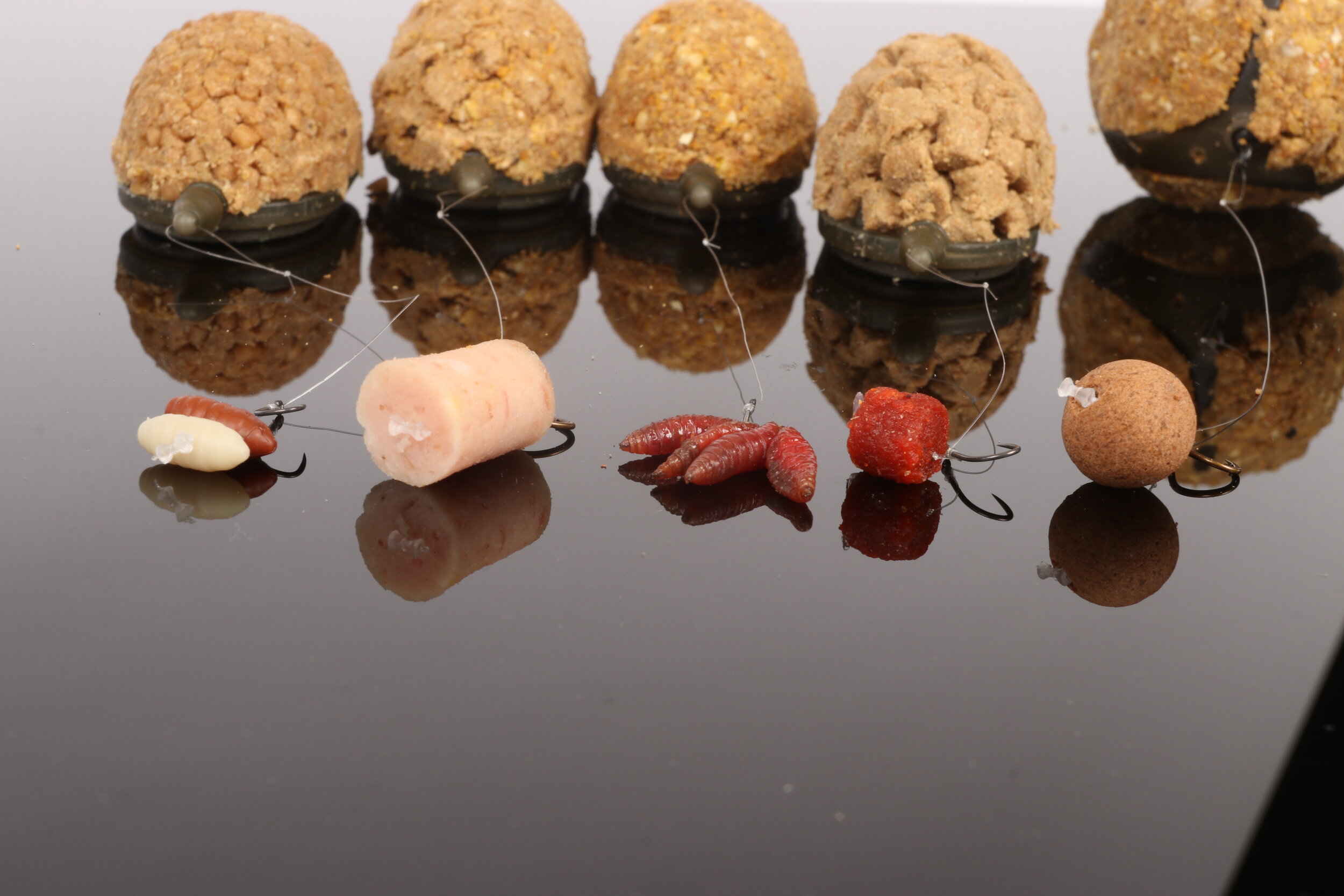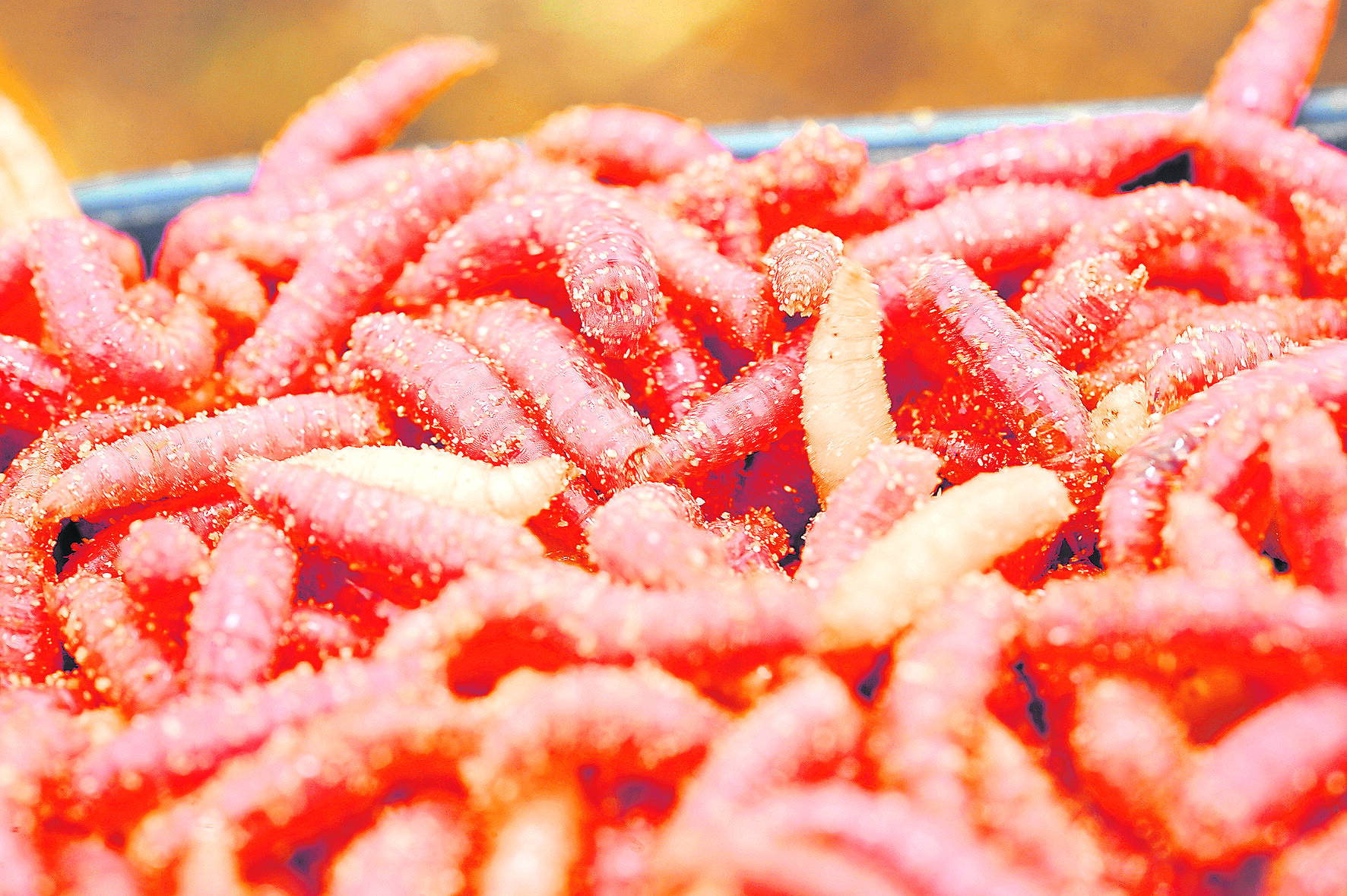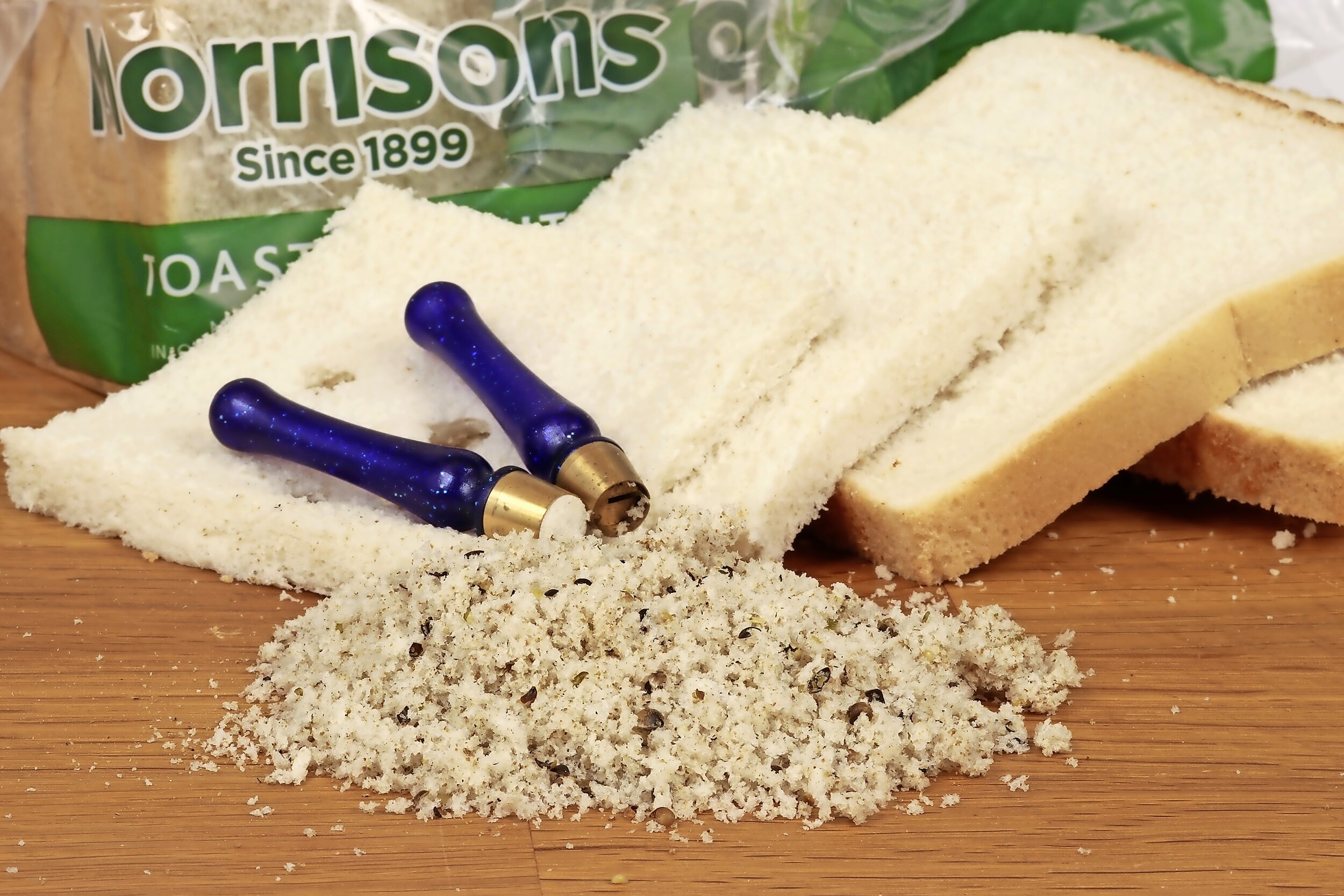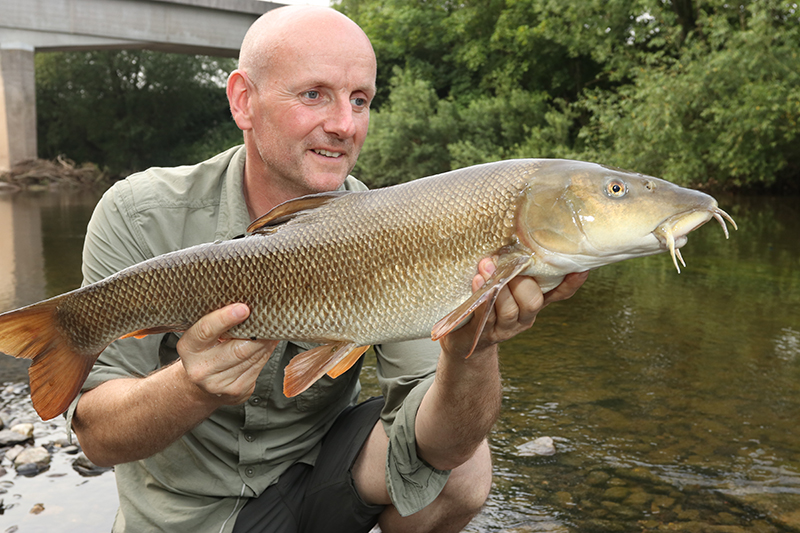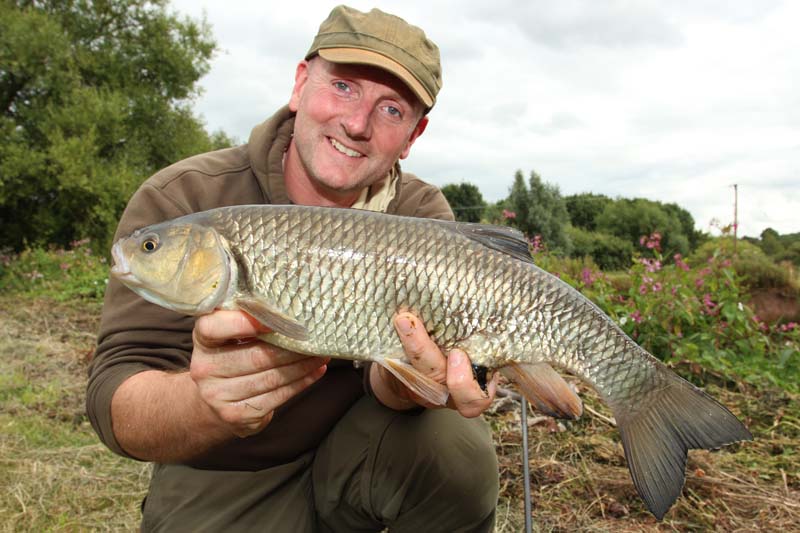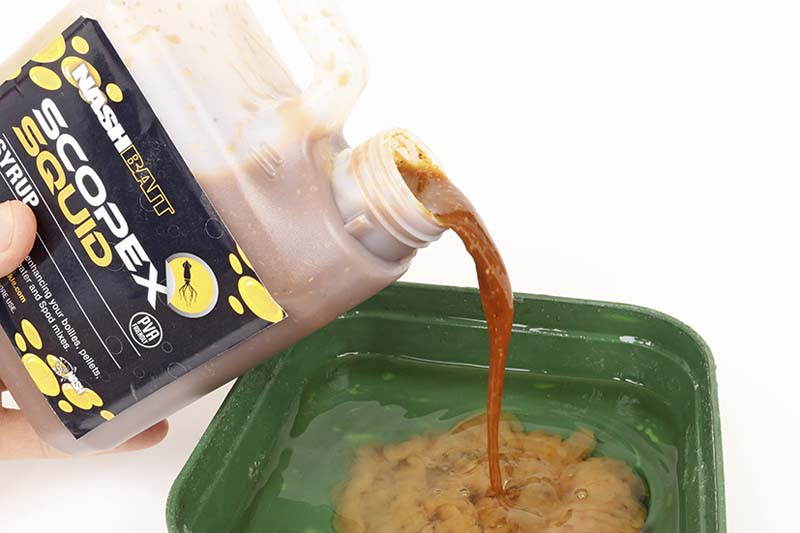Spend less and catch more with this method mix!
Want to catch more carp while fishing? then take a look at this amazing carp fishing method mix from Angling Times columnist and Nash backed Paul Garner. We asked Paul to give us his best carp fishing bait on a budget and he came back with this golden piece of information.
Rather than use a Method mix that breaks down quickly, I much prefer a slower release of bait from the open frame of the flatbed feeder.
This ensures that the the bait on the feeder will remain the focus for the carp even when their frantic grubbing around on the bottom, complete with waving tails, is washing the pellets all over the swim.
To get this slower release effect is simple – I mix a small amount of groundbait in with the soaked pellets, as here...
1) Cover a pint of 4mm coarse fishery pellets with water and let them stand for four minutes to absorb some of the water.
Pour off the excess water and allow the pellets to stand for a few minutes more until they are soft all the way through.
Add just a sprinkling of Method groundbait to the pellets and mix well so that the dry groundbait evenly coats the pellets.
Use a Method mould to firmly press the pellets on to the feeder in the usual manner.
Leave the hookbait just outside the feeder so that it is not obstructed by the pellet feed.
How to boost your boilie attraction with Paul Garner
I like to boost my boilie hookbaits in several different ways to increase their instant and long-term attraction. If you are fishing in the margins, or spodding out bait, then this is the mixture that I favour.
1) Put together a mixture of different sized boilies, all with the same flavour.
2) Next, crumble some more boilies, again of the same flavour, into the mix.
3) Pour some hot water over the baits – just enough to cover them will be sufficient.
4) Add a teaspoonful of liquid food to each pint of boilies. My favourite is Scopex Squid.
5) Add some hemp oil or tiger nut extract to the soaking baits.
6) Leave the baits to soak and soften for about an hour.
The best hookbait to use when fishing.
Paul Garner explains what his favourite hookbait is and what makes it so perfect.
What makes the perfect hookbait? Mine would need to have the right texture, breakdown speed and buoyancy. It would be easy to hook, of a perfect flavour and colour, and I’d want to be able to change the size and shape quickly.
That’s a big ask, and most baits fall down on one or more counts, yet I’ve been using one that fits the bill perfectly for two years.
Initially developed for fishing the Method for crucians, my set gel baits have become firm favourites and have caught me loads of different species, from carp and tench to chub and barbel.
The beauty of these baits is their versatility. Easy to make, they can be adapted to suit almost any situation and can be used with a huge range of additives for true customisation.
Gels are long-lasting in water, staying intact for several hours. The outside becomes almost slimy as it absorbs water and begins to break down, creating a lovely flavour trail.
I do believe that fish generally prefer softer baits, and gels offer the perfect compromise between a soft outer skin and a rubbery structure.
WHAT IS IT?
The secret to making my gel baits is a product known as Vege-Gel that you can buy from most supermarkets.
I came across this gelatine substitute when first playing around with set baits, and after some experimentation I found that it worked perfectly. The active ingredients are natural gelling agents that set when heated. Vege-Gel is used in baking, but by increasing the concentration it sets to make the perfect hookbait. Better still, just about any liquid or fine powder can be added to give it a distinctive flavour.
PURE AND SIMPLE
Making gel hookbaits is very easy if you follow my method. On its own the gel has virtually no taste and a clear colour, so it takes dyes and flavours very well.
In fact, if you want a really bright bait, adding half-a-teaspoonful of powdered dye will give you an incredibly vivid colour.
The same applies with liquid flavours and additives. The bland base means that the flavour really comes through. Keep levels very low, though, as it is very easy to overdo the flavour level.
I normally stick to about half the manufacturer’s recommended level. Food dips and liquid foods, which are not so concentrated, are ideal for these baits, giving more margin for error and a much rounder flavour to the bait.
GROUNDBAIT HOOKBAITS
You are not limited to just liquid additives in gels. Powders such as krill, squid and liver can be added – and what about groundbaits?
Imagine being able to use a hookbait that has exactly the same smell as the groundbait that you are introducing! All you need to do is add a handful of dry groundbait to the gel liquid and you will produce baits with the same flavour and colour as the feed. This has proved a useful tactic when fishing groundbait on the Method feeder for bream, as the fish just hoover up the whole lot without even noticing the hookbait amid the crumb.
MICRO-MIX
Another gel technique that I have been trying out is hookbaits incorporating micro pellets.
Initially, I ground the pellets down to a fine powder before mixing them into the bait, but although this worked well, it was time-consuming. Eventually, I tried adding tiny 1mm-2mm micros, and they worked a treat!
Once again, the finished bait perfectly matched the feed, giving me a really distinctive hookbait.
The bottom line is that you can use just about any additives you like to gel baits, and by altering the amount of water added go from a super-soft to a firm finished bait that can be tailored to the style of fishing that you are doing.
Recently I have been using larger baits to target bigger carp, and this has been very successful too.
For bigger fish I make the slab of bait slightly thicker, and once it has fully cooled I cut it into cubes and fish it just like luncheon meat.
My results have been excellent, so why not give it a go?
Best carp fishing groundbait mix
A simple fishmeal-based mix will catch plenty of carp, but I do like to add a couple of proven additives and a handful of larger feed items to keep the fish grubbing around. This is a great mix of mine to get you started, but the choice of ingredients really is endless.
The base mix is ground pellet groundbait specifically for Method fishing, as this will bind very well.
Add a small amount of crushed hemp to add attraction and some activity to the mix.
Squid Powder added to the dry ingredients will increase the bait’s carp-attracting properties.
Into a pint of water goes a teaspoonful of food dip or liquid additive as a soluble attractor.
Slowly add liquid to the powdered ingredients. After five minutes you can add more water if required.
Boilie flake adds extra food value to the groundbait that will keep carp grubbing around for ages.
Add 6mm feed pellets to further boost food content. Go easy or the mix won’t bind to the feeder.
The mix should stick together but still break down into crumb when rubbed between your hands.
How to catch carp on maggots
In the winter months, catching big carp can be quite difficult as they seem to switch off from the usual feed of boilies and pellets and instead turn their heads towards more natural baits such as Maggots. Which is why knowing how to hook your maggots correctly and efficiently is crucial when it comes to catching more carp. Below are two ways of rigging your maggots the first way is via threading this when you thread maggots onto a hair rig creating a big ball of natural bait for the carp to feed on. The second way is to add corn to this mix as this gives off some colour that will help catch the eye of any passing carp.
We asked Nash backed Paul Garner to show us how to hook up these two rigs correctly when fishing for big carp.
Rigging maggots
Although maggots will catch the largest carp around, using such a small bait on strong tackle can be problematic. In open water you can simply scale down your rigs and use a bunch of maggots straight on the hook. I like to use a size 10 or even a 12 hook, as long it is a forged pattern that is quite thick in the wire.
Half-a-dozen grubs on a hook of this size is about right. I tend to hook the grubs through the head end, rather than the conventional way, as used this way they are less likely to mask the hook.
If you want to hair-rig maggots, there are several ways. A size 8 or 10 hook gives a secure hookhold.
Threaded: I use a fine sewing needle to load a bunch of maggots on to a piece of strong sewing thread and then tie this to a small rig ring attached to the hair.
This neat and simple method allows me to make the maggot baits as large or as small as I want with minimal fuss.
Maggot clip: Another simple alternative is to use a maggot clip loaded with grubs. Once again this is tied to the hair and then loaded with maggots. You can buy clips in several sizes to match the number of maggots you want to use as a hookbait. I tend to add a sliver of ring foam to the maggot clip to counterbalance its weight.
Corn and maggot: For a substantial hookbait, combine maggots with a grain of plastic corn. This rig incorporates a size 12 round bend hook tied to the end of the hair with the piece of plastic corn pulled over the point.
Three or four maggots are mounted on the small hook, the point of which is then pulled securely into the plastic corn.
The corn provides a visual slow-sinking hookbait, with the added benefit of the bunch of wriggling grubs. Fish this with a PVA stick.
HOW TO THREAD YOUR MAGGOTS
1) Thread six maggots on to a sewing needle, thick end first.
2) Slide the maggots off the needle and on to a length of sewing cotton.
3) Tie a small metal ring to the end of your hooklength to form the hair.
4) Slide on tubing and then tie on the hook itself, using a knotless knot.
5) Tie the threaded bunch of maggots on to the small metal ring.
6) The finished rig is very neat and all ready to catch you a winter carp.
CORN AND MAGGOT
1) Tie a size 12 hook to the hooklength and thread on a grain of plastic corn.
2) Tie on your main, unbaited hook using a standard knotless knot.
3) Hook five maggots on to the small size 12 hook with the corn above.
4) Attach the stick by hooking it through the dissolving foam.
Boost your pellet bags and catch more
Most anglers will use fishery pellets straight from the bag in their teabags, but they really could do with a boost when the water is really cold. Fortunately, this is easily achieved and takes just a few minutes – just follow my handy guide below.
1) Add a splash of Tiger Nut drink to the dry pellets. This needs to be just enough for a light coating so that is soaked up and slightly softens the pellets.
2) Crush a handful of Strawberry Crush boilies to a fine powder. Boilies are denser than pellets and so tend not to get washed around the swim by the carp so much.
3) Add about 25 per cent crushed boilie to the pellets. Crushing the boilies releases their attraction much faster won’t fill the carp up as whole ones would.
4) Add a pinch of the pellet and boilie mix to a PVA stick but not too much – you want to attract the carp, not give them food to compete with your hookbait.
5) Compress the bait in the PVA stick and tie off the end. For winter fishing you are aiming
to make a teabag around the 20mm-30mm diameter mark.
6) Use a safety boilie needle to pull the hooklength through the side of the PVA teabag and pull the hookpoint gently into the side of this compact PVA stick.
Six bait tips to help you catch big fish
What a year 2017 was for big fish! We've asked bait expert Dr Paul Garner to give us his expert opinion on some of the best baits he has used over the past year. Maybe you can take some of these into 2018 and lad yourself some amazing big fish.
SELECTIVE SOFT PELLETS
Tight magazine schedules often mean that I find myself on the bank having to catch fish for the cameras way before the fishing has really switched-on for the year. So it was this spring when, with the water temperature still in single digits, I visited the lovely Milton Lake at Old Bury Hill Fishery in Surrey.
The plan was to catch tench, crucians and perhaps roach using a chopped worm and caster approach. Only nobody had told the fish!
With just a single net roach to my name on a dendrobaena I switched lines to a shallow spot tight to the reeds where I had been trickling in a constant stream of 4mm expander pellets laced with flavour and sweetener. The aim was to pick up a few of the lake’s crucians, but when the float shot under I found myself playing a big roach instead. After that the bites became more timid as the crucians moved in and I spent a lovely afternoon trying to hit as many bites as possible. The odd marauding tench kept me on my toes amid a rapidly growing tally of bars of gold.
The moral of the story was that it is rarely too cold for soft pellets, especially if you flavour them. What I didn’t expect was that, on this day at least, the pellets would so comprehensively out-fish my more natural baits.
TINY BAITS EQUAL BIG BARBEL
The first few weeks of the river season were unusually warm and on the usually prolific River Wye, rolled meat or trotted punched salami scored best with lethargic barbel.
Tiny meat baits have caught me many different species, often of prodigious proportions. For barbel it was more about using a familiar bait in a different way. Regular doses of hemp and punched meat, with a tiny piece of meat on the hair, became my go-to tactic right through the low water of summer.
ALIEN BAITS ON TOP
hunting through the shelves of my local koi emporium a few years back I came across a carp treat that was set to revolutionise my summer surface fishing.
Looking like something out of a sci-fi movie, silkworm pupae are a well-known gourmet treat for pampered Japanese koi. Carp go loopy for these thumbnail-sized floating insects, but straight from the shop they are crispy and break up when you try to hook or band them. Soak them for an hour, though, and they soften up enough to be hair-rigged, yet retain their buoyancy – perfect.
On a magazine shoot for Improve Your Coarse Fishing at Chad Lakes in the Cotswolds the fish were proving difficult to tempt off the top. A few hours later, and with five fish under my belt, it was job done, thanks to my bug-baits.
NOT-SO-DAFT PIKE
Pike are generally thought of as being rather daft and easy to catch, but sometimes, on some venues, I beg to differ. Of the numerous pike that I have caught more than once on lures, not one has ever been caught on the same type of lure twice.
One fish that was caught at least six times over several years by several anglers came out on tactics as varied as a fly, a jig and a crankbait, but never the same thing twice! Coincidence? No way!
The same can apply to deadbaits, and on a busy venue I will swap to unusual species once the pike have been fished for over a few weeks. In early spring, in very cold water, the problem is compounded by the low temperature reducing the metabolism of the fish. Needing very little food, and sometimes failing to pick up baits off the bottom, pike can be hard to catch. Now I always use critically balanced baits in the spring and I catch my share of big pike, like this immaculate 32-pounder from Chew Valley Lake last February.
SIMPLE DAY-TICKET CARP
A bout of illness kept me off the bank quite a bit through the summer, and to say I was itching to get back fishing would be the understatement of the century!
Short-session carp fishing proved to be the perfect medicine, with plenty of bites keeping me busy and some surprisingly good fish putting in an appearance.
My tactics were just about as simple as they come – a hair-rigged wafter boilie on a nylon rig and a lead big enough to cast the required distance.
No pop-ups, Ronnie Rigs or Chods in sight! On these prolific venues the key to catching more than the odd fish was to keep the bait going in. Using a Spomb to thwart the seagulls, a couple of handfuls of Scopex Squid boilies would be fed after every bite to keep the fish coming back for more. Bites would often come as the Spomb was still crashing down, proving that the fish were attracted, rather than repelled by all the racket I was making.
These sessions were brilliant fun and I started filming them for my YouTube channel - dr paul garner. I have lots more day-ticket venues lined up for 2018, including some that hold mightily impressive fish, and you can bet I’ll be using simple baits and tactics.
NEVER BEEN A BETTER TIME
For decades we have treated lure fishing as a second-rate tactic, but take it from me, for electrifying predator action this winter it’s the way to go. Not only will this mobile approach make the best of the short winter days, but there is nothing to touch the adrenaline-inducing ‘hit’ of a fish on a lure.
There’s never been a better time to take up lure fishing. The amount of information available is at an all-time high, so whether you choose to spin, chuck lures or drop shot, you can learn the right way to go about it.
The highlight of my autumn were the incredible perch that I chanced across in a large reservoir. Working a soft plastic Pulse shad close to the bottom I had a faint tap as soon as I stopped winding and let the lure flutter down to the bottom.
After such a gentle bite I wasn’t expecting a personal-best perch to pop up in front of the net but a giant it was, proving the effectiveness of my favourite perch baits.
How to make a high-attract stick
PVA can be used with a wide range of different dry additives, and even liquids if they are ‘PVA-friendly’. This is one of my favourite stick mixes, but don’t be afraid to include your own favourite ingredients.
1) Grind up a handful of boilies into a fine powder. You can then either use these neat or mix them 50-50 with breadcrumbs.
2) Add your powdered additives to the boilie crumb. Make sure you mix well to evenly distribute the powerful attractors.
3) Add a few drops of boilie dip and mix well. The liquids will coat the boilie crumb and give an instant hit of flavour into the water.
4) Put about a tablespoonful of the boilie crumb into a fine PVA stick and compress it well down, using a plunger if possible.
5) Tie off the end of the stick – the finished PVA should be about 20mm in length, just enough for a single mouthful.
6) Thread the stick on to your hooklength and pull the hookpoint into it. A contrasting colour of wafter hookbait will really stand out.
How to prepare method pellets
Preparing micro pellets for the Method feeder is a simple process, even if you want to boost them with liquid and powdered additives.
Choose a brand of ‘sticky’ pellet for best results, or add a handful of groundbait to fishery pellets to ensure they bond together well...
1) Add liquid additives to the mixing water and stir well to ensure that they are evenly distributed.
2) Add the water to dry pellets – as with groundbait, add the water slowly and allow the pellets plenty of time to soak it up fully.
3) When the pellets still feel dry but bind together with a squeeze, stop adding water. After 10 minutes add more water if need be.
4) Add powdered additives to the pellets last and ensure that they are evenly distributed throughout the bait by mixing vigorously.
How to use hemp correctly when fishing for roach
Hemp is still a bait that so many anglers steer clear of when it comes to fishing for roach.
The seeds are fiddly to get on the hook, and when the angler finally gets a bait in the water he’s unable to catch anything.
That’s far from the truth. It may not every day that sees hemp work, but when you’ve got a swim producing a fish a cast on maggots and casters, there’s no reason why changing to hemp should lead to a halt in bites – provided of course, you’ve been feeding hemp from the word go.
This week’s coach is a real blast from the past – Pete Jayes. The Leicester angler has enjoyed a glittering career stretching back to his days with Ivan Marks and the Likely Lads.
Here are his top tips for catching big roach on ‘the seed’ this autumn…
Present it correctly
“Whereas maggots and casters are best fished overdepth, I think hemp works brilliantly when presented just off bottom and run over just a few feet of a river swim as opposed to way down the peg.
“I try and get the grain on the hook to act in the same way as the loosefeed underwater. Hemp on the riverbed won’t move with the flow, due to its weight, so why should the hookbait?
“I think roach line themselves up in the flow waiting for the hemp to arrive – if the bait acts suspiciously they won’t look at it.”
When tares work
“I never fish hemp without having a few tares with me because they are a brilliant hookbait that picks out the bigger roach in the swim. They are a much bigger bait than a grain of hemp, and they’re also easier to get on the hook.
“Once the roach are lined up on hemp it’s time to try a tare on the hook. I prepare my own, but to make them even softer I will freeze a few and then defrost them before use.”
Different rigs
“I always have two pole rigs on the go for hemp work because no two days are ever the same.
“You have to try different depths and shotting patterns to make the hookbait behave as much like the loosefeed as you can.
“I’ll fish a 0.4g bodied float plus a much lighter 4x14 slender Preston Innovations Chianti model. Both are shotted using nothing larger than No10 shot, as this allows me to move them up and down the line for different presentations. You can’t do that with heavier shots.”
feeding
“Varying how many grains of hemp you loosefeed is the road to ruin. I reckon roach like a constant stream going in – the more regular the feeding is, the better the fishing will be, so I fire in around 12 grains every run through and never alter this.
“Should I think that a change needs to happen, this comes by altering the shotting on the rig rather than how much I am feeding.”
Light lines, small hooks
“In keeping with the delicate presentation that I am trying to achieve, my lines and hooks have just as much finesse.
“A hook that’s too big and a line that’s too thick will make the hookbait act unnaturally underwater, so typically I fish 0.10mm mainline to an 0.08mm hooklink.
“Your hooks should be very light as well, but they need to have a wide gape to help the hemp sit properly.
“For me the best out there is a Kamasan B511 in a size 20 or 18.”
Best winter baits for fishing
For many anglers, now is the time when sport is at its very best.
Most species are feeding up hard to pack on weight for winter, and a well-presented bait will see plenty of action. We start with 15 autumn-gold nuggets of advice from big-fish expert Dr Paul Garner...
1) Try dead maggots or worms
Two baits stand out for crucians right now – two dead maggots fished over a light scattering of groundbait can work wonders, but a close second comes half a dendrobaena, hooked at the broken end to leak off the juices.
2) It's a wrap for barbel
When boilie fishing for barbel I rarely cast out without wrapping some matching paste around the hookbait. This can work wonders if the fish are proving finicky. A useful trick is to use a 12mm hookbait wrapped in paste, but feed 15mm baits.
3) Gob-stoppers trick wily carp
With everyone using boilies of 18mm or less, you can fool wary carp by going large and 24mm or even larger baits. Scale up your hook size ti match the big bait.
4) Enjoy traditional roach sport
Many of our larger rivers are teeming with roach at the moment. One of the nicest ways of catching them is to use loosefed hemp with prepared tares on the hook.
Start with a pinch of hemp every cast and fish a matching grain on the hook. Once you start getting bites regularly swap to a tare and your reward should be a bigger stamp of fish.
5) Big bream are feeding up
A windy autumn can see shoals of big bream feeding hard. I lay out a big spread of bait to hold the shoal.
Into the mix go a tin of sweetcorn, two pints of dead maggots, some mini-boilies and soaked flaked maize. Bind the lot together into balls with a mix of brown crumb and layers mash.
6) Mid water baits for Rudd
For consistent autumn rudd sport try using a 10mm pop-up or a lump of breadflake on a 12ins-36ins hooklength, so the bait is presented in midwater
7) Stock up now
Get your deadbaits stocks sorted now to ensure a ready supply for winter. Big smelts are always in short supply, so order early.
Split bulk baits into small airtight bags and freeze down. Dip each bait in cold water before freezing, as this will stop them getting ‘freezer burn’.
8) swap to a cone
A pellet cone is a much neater presentation than the Method feeder, and really comes into its own in the coming weeks, especially on venues where the carp have seen it all over the summer months. Vary the size of the cone to control the amount of feed you introduce.
9) The subtle snowman
Very often carp never actually get the hook into their mouths, just the boilie. This can be even worse with a snowman presentation. So try my ‘subtle snowman’ (below), made by cutting a 15mm boilie and a 15mm pop-up down to form a single back-to-back bait.
10) Feed, feed, feed for chub
The key to unlocking brilliant autumn chub sport comes down to how you feed. The simple solution is to drip-feed as regularly as you can. This could be as little as three pellets or maggots every few seconds.
11) Fry-feeding perch
Now is the time to target perch, which predate heavily on small fish which are in the margins over the next few weeks. Use small lures for this – a selection of bright green and more natural hues.
12) Go soft for roach
On many fisheries roach have developed a love of pellets. This can cause problems with fast, hard-to-hit bites. This phenomenon is simply down to both baits being hard, and to combat this try using soft hooker pellets – I find 4mm baits are best.
13) Flavoured meat in floods
Try to coincide barbel trips with the river falling back after a flood. If you have to fish as the river rises, stick to a straight lead and a large smelly bait such as Crab & Krill flavoured luncheon meat.
14) Slug it out for chub
Dew-laden mornings will see hundreds of slugs and snails attacking your garden plants. Rather than chuck them over the neighbour’s fence, why not collect them for an afternoon’s chub fishing?
15) Try red corn down the edge
A float down the edge works for carp that feed in the margins at dusk.
Add a few drops of boilie dye to a tub of corn the day before fishing and you will be left with a lovely dark-red bait that is eaten with enthusiasm.
20 amazing carp fishing bait tips
When it comes to Carp fishing bait it can be as simple as hair-rigging a boilie straight from the bag and waiting for the alarm to sing or putting that extra time and effort into adapting your tactics, and especially your baits, to the conditions in front of you. There are literally hundreds of little tips that can be employed, Which is why we want to take a look at some of bait expert Dr. Paul Garner's best kept secrets that are guaranteed to catch you more carp.
1) Don’t neglect meat
In a world where carp fishing is dominated by boilies it is very easy to overlook how effective meat is as a big carp bait. Easy to flavour, of an ideal texture, and with masses of natural attraction, meat has a lot going for it. The biggest problem can be that it’s quite a soft bait and can be whittled away by smaller fish. To avoid this, use larger chunks.
To stop meat flying off on the cast try frying it to give it a tough skin. A large boilie stop is also critical. I use pellet stops, which not only have a large surface area to hold the bait on, but also pull into the bait, leaving it virtually invisible.
2) Slick-up floaters
Adding a small amount of fish or hemp oil to floating pellets can boost their attraction. Just add a tablespoonful of oil to a kilo of pellets and shake well so that they are evenly covered.
Another benefit of adding oil is that it will flatten the water surface on windy days, creating a slick that makes it much easier for you to spot the hookbait.
3) Why carp love hemp
Hempseed mimics tiny freshwater snails, and carp can become preoccupied on it to the exclusion of all else. The oily liquid produced when hemp is soaked is also incredibly attractive to carp and contains amino acids and natural omega oils. I’ll often use just a handful to kick-start a swim that I am baiting with boilies. The hemp will pull in the carp and stimulate them to start looking for food, in this instance a scattering of boilies.
4) Shelf-life or frozen?
Modern preserving methods mean that shelf-life baits often contain very few additives. They rely mainly on being dehydrated to stop them from going off. This is the same drying process that is used with pellets, and in itself does not put the fish off.
So if tiny amounts of preservatives do not affect these boilies, what are the advantages of using freezer baits over shelf-lifes?
They tend to be softer, and get to work faster in the water as they release their attraction. Freezer baits do need to be kept frozen, though, and should be discarded once they have been out of the cold for more than a few hours.
So for short sessions it’s frozen, but on longer trips it’s shelf-lifes.
5) Give boilies a good soak
Shelf-life boilies are produced by air-drying. This removes much of the moisture from the baits, giving them a hard texture and a firm outer skin. While this stops them going off, it does mean that it can take quite a long time for them to soften in water and release the locked-in attractors.
To overcome this problem it’s always best to soak your baits the night before a trip in a bucket of water– try not to use chlorinated tapwater if you can help it.
Much better is to use the water left over from cooking particles, such as hemp. Alternatively, add some boilie dip to the water to not only soften them, but also give your baits an extra boost.
6) How much bait?
Carp eat a lot – up to three per cent of their body weight every day when conditions are right – but does this mean that we need to use a lot of bait to catch them?
Most carp recognise pellets and boilies as food, so one bait put in front of them can be enough. Introducing more can be important to hold them in the swim and to encourage them to feed confidently.
I tend to introduce no more than a handful that I think one carp can eat. Often my hookbait is among the last to be eaten, meaning that I have enough bait out there to interest the fish but don’t have to wait long for a bite.
7) Prepare salty particles
Salt is a popular additive for particles and spod mixes, but it’s not just a matter of adding a handful to your bait.
The best types are sea salt and rock salt, both based on sodium, a tricky element for freshwater fish to consumer. These salts also contain useful trace elements that the carp may be able to detect in the water. Avoid common table salt, as this is much less effective.
Because salt can dry out particles and prevent them from splitting, always add it after the baits have been cooked – ideally as they are cooling down, as this will help the salt to dissolve. Add a tablespoonful to each pan for best results.
8) Mix up your feed
One of the most important things I have learned about surface fishing is how carp can become very picky about what they eat. They can easy become preoccupied with tiny baits.
To overcome this problem I vary what I feed. At the start it’s almost exclusively with tiny Riser pellets, but as the fish gain confidence I quickly shift to a 50:50 mix of Riser pellets and 11mm floating pellets.
Eventually, if the fish are competing for the bait and feeding hard, I switch to just the larger baits, as these better match the size of my hookbaits.
9) Always carry paste
A wrap of paste can double the number of bites, thanks to its fast leak-off of attraction – often far more than from an equivalent boilie or pellet.
Most bait companies produce a dedicated paste that matches their boilies, which makes sense to use, but there are alternatives.
A paste made from ground pellets and bound together with egg works very well indeed. An even simpler option is to cover your bait with some cheese spread!
10) What size boilie
Boilies come in a wide range of sizes, so which is right for your fishing?
It’s worth bearing in mind the size of fish you are after. For single-figure fish, 8mm-10mm baits are best. A double will easily eat a 12mm-15mm bait, a twenty 18mm and beyond.
Boilies were originally developed to help deter species other than carp, so if you are being bothered by bream, switch to a larger bait. While 15mm boilies are by far the most common size used in the UK, why not try something different?
Few anglers use 20mm or even 24mm boilies, although even a modest-sized carp will consume these easily.
11) Add some fish
All coarse species love the taste of fish, and carp are no different. Try adding a small amount of cooked fish to your spod and PVA bag mixes to give them a real boost.
Tuna is the oily fish most often used for this job, but other cheaper and more sustainable options do it just as well. Try tinned pilchards or sardines in oil or brine as a substitue for tuna.
Mash the contents of a tin up with a fork and add to your spod mix.
12) Perfect tiger nuts
Tiger nuts are almost impervious to small fish, are very attractive to carp, last indefinitely on the hair and are cheap to buy. You only need a handful for a session, often mixed with some hemp if you want to introduce more feed. Tigers can be bought ready-prepared but I still like to make my own, which is a simple process.
Start off by soaking the dry tiger nuts for a minimum of 24 hours. This is to allow them to swell up to their full size, as they come in a dehydrated form. Next, boil them for at least 20 minutes. They will not go soft, unlike other particle baits, but boiling will ensure that they are cooked through and cannot germinate or swell further.
Finally, freeze them in small session-pack batches ready for use.
13) Try a zig
It takes confidence to cast out a single piece of rig foam or a trimmed-down pop-up on a long hooklength and expect to catch a carp in mid-water but believe me, it is a tremendously effective tactic at certain times.
The secret is to understand when it is most likely to work.
In spring, when the sun is warming the upper layers of the water, carp will often be found up in the water, especially in swims sheltered from any cold winds.
In the middle of summer carp will once again come to the top on hot, sunny days to absorb the sun’s warmth and feed on the surface.
Both these times are ideal for zig fishing and either a lone zig, or spodding soup over the hookbait, can be a very effective tactic.
14) Double-up for big fish
There’s a lot to be said for the old adage ‘use big baits for bigger fish’, especially where carp are concerned. Carp have big mouths and so can easily handle larger baits than we might commonly imagine.
While 15mm boilies might be the most commonly used, why not double up, fishing two on a hair to give yourself a larger bait? Alternatively, try using a 15mm bottom bait and a 10mm pop-up to create a slow-sinking ‘snowman’ presentation.
15) Flavour fake baits
Fake baits work very well straight from the packet, but I also like to keep some soaking indefinitely in a tub of Betalin for those days when they need an extra boost.
This is particularly true when zig fishing, as the sickly-sweet flavour of this additive slowly leaches out of the bait, creating much more attraction than the single unflavoured hookbait could ever do.
Another favourite is to soak bottom-baits in Crustacean extract. This super-pongy additive is loved by carp and is perfect for flavouring plastic corn, giving it a massive edge over unflavoured plastic.
16) Which colour is best?
Fashions in bait colour come and go, yet some general rules still apply when it comes to choosing the right one. Because carp are cold-blooded, their senses become dulled in winter, so bright coloured baits make a lot of sense.
This is the time to concentrate on using white and pink baits on the hook and as feed.
In summer, darker colours are often more effective. Try browns, purples and reds at this time of the year. Especially in clear water, these darker colours are less likely to spook the fish when they are feeding over a bed of bait. It is worth trying one bright bait on the hook, as this can often bring a fast bite.
If you are looking for an edge, then try making some baits in a less popular colour. Green and blue are bait colours that the fish rarely see, but they can prove to be very effective.
17) Use stringers
A very neglected tactic, but one that I use a lot, is to attach a three-bait PVA stringer to the hook. This can be wrapped around the hook to ensure that no weed can catch on the hook point as it sinks. The extra weight of the freebies also means that the rig is much less likely to tangle on the cast.
Having a little pile of baits with the hookbait at the centre can often bring extra bites, as it makes the hookbait really stand out.
18) Make a wafter boilie
Wafter hookbaits are very much the rage at the moment, for good reason. These semi-buoyant hookbaits only just sink, making them much easier for carp to suck in, as they balance the weight of the hook well. Using wafters not only means that the chances of the hookbait getting into the carp’s mouth are higher, but it also goes further in, giving improved hook-holds.
Not all baits are available as wafters, but you can make your own. Use a boilie corer to remove the centre of a boilie and then insert a matching piece of rig foam. By adjusting the amount of foam used you can control the buoyancy of the finished bait very accurately.
19) What type of pop-up
When I want a really bright hookbait that will stand out to any passing carp, a shelf-life ‘airball’ pop-up is the best option. These baits are really bright, stay buoyant for a long time, and can be left out for days on end if need be. If I want a pop-up that matches my freebies, a cork ball or cork dust pop-up is a better option.
Make these by moulding a small amount of boilie paste around the hookbait and then boiling it to make a pop-up that perfectly matches the feed. Cork baits stay buoyant for a long time, but the skin of boilies will eventually break down – okay if you are leaving them out overnight, but not if you want to leave the baits out indefinitely.
20) Add some flake
A tactic that the carp are unlikely to have seen on most venues is fishing a single boilie hookbait over a carpet of boilie crumb.
Make crumb by blitzing boilies in a food-processor, or buy it ready-made. Try not to reduce the bait to dust. I like to have a mixture of particle sizes, from lumps of boilies down to a crumb.
Because crumb is quite a fine feed it will get moved around by the undertow and by carp in the swim, so it is best to bait up little-and-often. Try introducing a couple of handful every hour or two for best results.
Fishing bait | How to flavour your luncheon meat
When fishing with meat there are a few things i like to do, the first is frying my luncheon meat. Most of the time I am more than happy to use meat straight from the packet or tin, but there are times when altering its appearance can bring extra bites.
However I am a big fan of flavouring these baits rather than colouring them, although red meat seems to be all the rage. Do yourself a favour and try giving them a flavour boost too. You don’t have to restrict yourself to savoury flavours either. Sweet additives, such as Scopex No.1, are just as effective, so don’t be afraid to ring the changes. Check out the step-by-step guide below
Chop a tin into 6mm cubes the night before fishing – a meat cutter makes this an easy task.
Add a teaspoonful of flavouring to each tin in a sealed bait container and shake well.
Add a squirt of liquid colouring. Once again, shake well to apply the additive evenly to the cubes.
For an extra twist, add a pinch of powdered additive – squid, and fishmeal groundbait, are great.
Top Summer Fishing baits
Check out the best fishing baits around that will guarantee you success on the banks! Bait expert Dr Paul Garner talks us through what his top fishing baits to use this summer will be and what thinking outside the box can deliver.
scale down your cubes
Luncheon meat is an incredibly effective bait, and lends itself to being used in many different ways. Over the past couple of years I have been fishing tiny cubes or punched cylinders of meat for all manner of different species, and it seems it’s often hard to beat.
To produce plenty of hookbaits and feed, simply use an MAP meat cutter to chop up a full tin into 4mm baits. These tiny cubes will catch just about every fish that swims.
fish a classic combo
My go-to baits for summer barbel are hemp and caster. This classic combo of very small baits encourages the fish to feed even with the sun on their backs.
I normally use a bait dropper to introduce a 4:1 mix of hemp and caster, three loads every 15 minutes for a minimum of an hour.Then superglue three real casters or two fake casters on to the hair and hold on to your rod
mix tougher paste
There is a real skill in fishing super-soft paste down the edge for carp. With practice you can use a paste that literally melts off the hook, but for us mere mortals this can be a frustrating game.
Fortunately, right through the summer much firmer baits work well. These can be moulded around the hook and swung out without using a pole cup. Fibre pastes work especially well. Its stringy texture adheres to the hook, only falling away when you lift the rig out.
blitz some corn
Messy, maybe, but liquidised sweetcorn gives you a fantastic edge when fishing for big carp, match-sized fish, tench or bream.
Cheap and nutritious, you can use it in spod mixes, to create a cloud when fishing zigs, cupped into the margins, or mixed with groundbait.This salty-sweet, pungent bait will drive the fish wild.
feed while trotting
Running a big Avon float down a pacey glide is just about as good as summer fishing gets, but you go through a lot of bait. Each run through will see a good pinch of bait introduced before the float is released.
To keep the cost down I use hemp and 6mm Halibut pellets as my feed, with a 6mm or 8mm pellet on the hook. Don’t mix the hemp and pellets together as they sink at different speeds – the pellets need to be introduced further upstream than the hemp so that they reach the bottom at the same point down the peg.
beat weed with bags
Presenting baits properly in weed can be a nightmare. I use a small solid PVA bag with the entire rig inside. To ensure that the bag packs down really tightly, fill it with micro pellets or damp groundbait – this will ensure that the bag flies straight on the cast. A small trimmed-down wafter boilie is the ideal hookbait inside a solid bag.
Flavour your meat
A lot of polony and luncheon meat goes into commercials in summer, so try colouring and flavouring your chopped meat to give it a new lease of life. Add a teaspoonful of flavour per tin, shake well and leave overnight.
Don’t be afraid to try some unusual flavour combinations. Scopex meat works just great, especially when you add a dash of super-sweet Betalin to it.
Use your loaf
As a hookbait for surface-feeding carp bread takes some beating, especially on urban venues where the local birdlife waxes fat on the stuff.
On the river, too, bread can be an excellent way of targeting chub, both on the surface and trundled downstream under a heavy chubber float. And if big rudd are your chosen target a loaf of fresh bread should be an essential in your bait bag.
Spice up barbel baits
Once the river season is a few weeks old I will soak pellet and meat hookbaits in a spicy concoction that appeals to barbel.
To a bottle of hemp oil add a teaspoonful of chilli powder and the same of garlic powder. Shake well and you have enough bait soak to last all season. The three ingredients combine in a manner barbel find hard to resist.
switch to pellets for big roach
Summer hemp and tare fishing will catch roach even when the water is gin-clear. The only problem is that bites can be lightning-fast and easy to miss. I think this is because roach don’t particularly like the hard texture of hemp and tare hookbaits.
Instead of using seeds on the hook, try a 4mm hooker pellet instead. The softer the pellet, the more bites you will hit.
get bream feeding on the method
The flat Method feeder has revolutionised carp fishing since its inception, and the same is rapidly happening to bream fishing too.
Loaded with mini-halibut pellets or a fishmeal-rich groundbait, the flat Method is the ideal way of delivering a mouthful of bait right where you want it – next to the hookbait. Try using a 10mm boilie or a similar sized pellet on the hair and ring the changes to bring more bites.
Go stalking with slugs
When the rivers are ‘on their bones’ in summer go stalking for chub with minimal gear. Chub have great eyesight and can be very wary of many baits, but a big lobworm or slug cast upstream of them is often gobbled up in an instant. If you’re squeamish, try a big lump of luncheon meat, although don’t expect the reaction to be quite so explosive.
try Wafters on the Wag
A pellet waggler gives carp more time to intercept the bait on the fall, while it is imitating the free offerings being fired in regularly.
A slow-sinking mini-boilie wafter is the ideal hookbait. I like to carry a range of different colours, as this can be an important element to success on some days.
Use a ‘sighter’
A simple way of increasing the number of bites you get is to use a bait that stands out from the free offerings.
This could be a combination of red and white maggots on the hook while feeding just red, or a brightly coloured pop-up fished over a bed of dark boilies. Often I will use a grain of plastic corn in a contrasting colour (pink and white are best) on top of a dark boilie or pellet, to make the hookbait stand out from the crowd.
Wrap up your lead
Here’s a simple, but very effective tip – dampen a few handfuls of pellets until they become sticky, and every time you cast out, squeeze a palmful around your lead.
The pellets will fall away in a matter of minutes, leaving a lovely pile of super-attractive feed, ideal for carp and bream.
How to make perfect carp floaters
Making floater cake is no different to baking a cake, so most of us will have all the necessary equipment to do this in the kitchen. A food mixer is handy, but you can just as easily make the sticky mix using a fork.
Add 2oz of wheat gluten to Victoria sponge mix. This ingredient gives the finished bait a tougher, denser consistency.
Now add 100g of butter to your mixing bowl.
Add two large eggs and 150ml of milk to the mixing bowl.
A teaspoonful of concentrated liquid flavouring can now be added to boost the flavour. I tend to use sweet or fruit flavours.
Slowly add powdered ingredients to the liquid ones and mix for at least two minutes until a sloppy, lump-free consistency is attained.
Pour the mix into two tinfoil baking trays lined with greaseproof paper and sprinkled with hemp oil to stop the cake sticking.
Bake the mix for 25-30 minutes at 160˚C. Make sure the cake is cooked right through and not still soft in the middle.
Leave the floater cake to cool, then remove it from the tray. The block of bait can be cut to size on the bank or frozen until required.
Dr Paul Garner's 10- minute make | Pellet mash
Pellet mash is best prepared the night before fishing, and it takes only a few minutes’ work before it is left to soak until morning. Alternatively, speed up the process if you are in a hurry. A couple of kilos of bait will be plenty for a day session.
Soak 6mm halibut pellets in cold water for 10 minutes. You can speed up the process by using warm water.
Pour off the water and add a teaspoonful of hemp oil to the pellet mix. Shake well to distribute the oil evenly.
Once the water is absorbed, mix them up. Those at the bottom turn to mush, those at the top are soft, but still intact.
Two handfuls of dry Method Mix groundbait will soak up any excess moisture and help bind the pellets together.
Dr Paul Garner's 10-minute make | Grilled meat
In hot weather luncheon meat can become very soft as the fat in it melts. To make a much tougher bait, try frying the meat first. This cooks out the fat and puts a tough skin around the bait.
Cut a tin of luncheon meat into three-quarter-inch slices.
Heat up two teaspoonfuls of cooking oil in a frying pan.
Add a teaspoonful of garlic powder to the pan.
Fry the meat for two to three minutes on each side.
Break the meat into chunks to give you the perfect bait size.
Dr Paul Garner's 10-minute make | Boost your pellet feed
Plain pellets will catch plenty of carp off the top, but you can test out different flavours and attractors very easily by top-coating your feed with different liquids. I also like to make up some PVA sticks of pellets that allow me to catapult baits much further, should the fish be at distance. Normally I put in this preparation at home so that I am not wasting time on the bank.
Mix one pint of 3mm Riser pellets with two pints of 11mm floating pellets. This mix creates a much tighter PVA stick than big pellets alone.
Add two teaspoonfuls of TG Active boilie dip to the pellets and shake so the bait is evenly covered, then allow the liquid to soak in for 10 minutes.
Wide-bore PVA mesh makes up small, round sticks. These can be catapulted accurately up to and beyond 50m if the fish are well out in the middle.
Store PVA sticks in a bucket of pellets. This absorbs any moisture that might melt the PVA, and the sticks will always be ready to hand.
How to make the bread and corn super mix
It may not look the most appealing bait, but Craig Mortimer’s budget bread and corn mix is unbeatable!
Whether a carp is 3oz, 3lb or 30lb, they will never turn their noses up at a free feed of bread and corn. Match anglers use both to great effect right through the winter and well into early spring, so why not adopt this approach when targeting specimen carp?
Even if the fish are completely dormant due to the cold water temperature, the bright visibility that these two baits bring to the table is usually irresistible. Being primarily flavour, colour and cloud, there is nothing to really feed upon, apart from the hookbait.
Gardner, Sticky and Daiwa-backed Craig Mortimer has been using this mixture of ‘match baits’ over four years and his results speak for themselves, with a 31lb 12oz being the biggest to fall to his tactics. With this in mind, Craig’s carping approach just had to be checked out, so we met the 30-year-old Ipswich rod at The Nunnery Lakes complex near Thetford, Norfolk and asked him to guide us through this magic carp mix.
How to make Craig's mix
Starting with a whole fresh sliced white loaf, he places the lot in a bucket and adds water to produce a mush. Next in goes a 900g bag of frozen corn that has been liquidised, as well as another full bag of frozen whole corn.
“I like to add around 1/3 to half a kilo of crushed Manilla boilies and 100ml of the corresponding liquid as this enhances the flavour trail and gives the bigger fish something to graze on without filling them up,” he added.
“If I am fishing somewhere shallow or over the top of zigs and I want the slop to make more of a cloud in the water, I’ll add a little more liquid and lake water. Alternatively, if the venue is deeper, I stodge it up with the addition of more liquidised breadcrumb or groundbait.”
The beauty of Nunnery is there are few, if any, silverfish, but if a water does hold bream, you can get plagued by them at times. By fishing a boilie on the hook, if you do hook a bream or roach, it will generally be of a better stamp, so still worth catching.
“I have found in the past that feeding silverfish will draw in the carp, which soon bully these fish away from the swim, so it’s a win, win,” Craig told us. Follow the simple steps below to create your own corn mix on the bank!
Start by putting a whole loaf of fresh, sliced white bread in a bucket, and add water
Use your hands to break up the bread and crusts into a soggy mush
Once you’ve got rid of all the lumps put on the lid and drain off any excess water
Next into the bucket goes a 900g bag of frozen corn that has been liquidised
Give the mix a good stir until the liquidised corn is fully mixed in with the bread mash
Another whole bag of corn, this time frozen, is then added to the bucket
The addition of half a kilo of chopped boilies provides a few bigger food items for the carp
A glug of Cloudy Manilla liquid helps to enhance the flavour trail of the mix
Dr Paul Garner's 10-minute make | Spicy carp corn
Carp love corn and they love spicy baits, so why not combine the two in this cornucopia of flavours that can be used in PVA sticks and bags to stunning effect?
Drain off the liquid from half a tin of corn and then blot it dry using a couple of sheets of paper towel.
Add a tablespoonful of chilli flakes to two tablespoonfuls of hemp oil and mix this with the corn. The oil will prevent the PVA melting.
Add a handful of TG Active Stick Mix to the spicy sweetcorn. This will enable you to compact the PVA sticks that bit better.
Make a PVA stick using the corn mix. This should be about 4ins long.
The finished stick can then be hooked on and will melt within seconds, leaving a spread of tasty corn around the hookbait.






